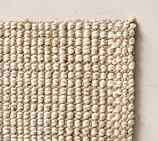Our Blog
Please feel free to post a question or just join the conversation.
Wool and Jute Rugs

The Uses of Jute in Rugs
For those of you that are not aware, Jute is a long, soft, shiny vegetable fiber that can be spun into coarse, strong threads. It is produced primarily from plants and is one of the most affordable natural fibers and is second only to cotton in amount produced.
Jute fibers are composed primarily of the plant materials cellulose and lignin. Besides being used for rugs, it also has a great variety of uses such as burlap, rope, twine, or other matting uses.
Regarding the use of jute in rugs, it has two forms that are most commonly used. As a backing of a rug, both as a primary backing providing a tufting surface and as a secondary backing used for support and it also is occasionally used in combination with other fibers like wool as a secondary face yarn.
Now that we understand where jute came from and some of its uses in rugs, let discuss some of the problems jute can present. You need to understand that jute does not get along with any liquids. Never mind red wine or coffee, Im talking even water. When jute gets wet from a spill, the moisture is absorbed into the fibers relatively easily since it is a cellulose fiber. The moisture then will cause the natural color and lignin to bleed. This bleeding will either migrate into adjoining fibers causing them to stain or if it is in an area that is composed of all jute, the color will migrate to the outer edge of the spill. This will result in both a darker ring on the outer edge as well as a lighter color in the stained area caused by the loss of color migrating to the outer edge. So, that means a rug that contains jute can not be cleaned with any type of wet process. Considering soil and most other common reasons to have a rug cleaned respond much better with a wet cleaning process as compared to any type of dry cleaning process, solvents used in a dry cleaning process will usually not show any improvement in the cleaning of jute, they will also void the warranties on many rugs containing wool or other fibers or rugs with any type of latex backing.
Another issue is when jute is used in the backing of the rug. Again, if a rug gets too wet, whether from a spill, a leak or just trying to clean a stain from a carpet, once the jute gets wet it will also bleed and as the rug dries, the lignin will wick to the surface fibers which can easily stain other natural fibers like wool.
With over 45 years in the carpet cleaning business, I have seen countless spills, pet stains, leaks, or other issues that have caused permanent stains that without the jute, never would have become a problem. I love the looks and the added texture that jute can offer as a visual experience but from my practical side, my recommendation is to avoid jute if at all possible.
note_stackRelated Posts
- Area Rugs With Multiple Pile Heights - About Rugs Apr 24
- Area Rugs With Wrinkles - About Rugs Jan 16
- What You Should Know When You Buy Area Rugs - About Rugs Mar 15
- Cleaning Wool Carpets - About Rugs Mar 31
Author's recent posts
- Towns That We provide Service To Feb 20
- Wearing Shoes in Your Home Aug 1
- Restoring Protected Leather May 28
Blog Categories
-
 Spot Cleaning (13)
Spot Cleaning (13)
-
 Carpet Cleaning (13)
Carpet Cleaning (13)
-
 About Rugs (5)
About Rugs (5)
-
 Upholstery Cleaning (3)
Upholstery Cleaning (3)
-
 Fabric Protection (2)
Fabric Protection (2)
-
 About Carpets (2)
About Carpets (2)
-
 Leather Upholstery (2)
Leather Upholstery (2)
-
 Fabrics (1)
Fabrics (1)
-
 Stains on Carpets (1)
Stains on Carpets (1)
-
 Discussions on Carpet & Upholstery (1)
Discussions on Carpet & Upholstery (1)
-
 News (1)
News (1)
